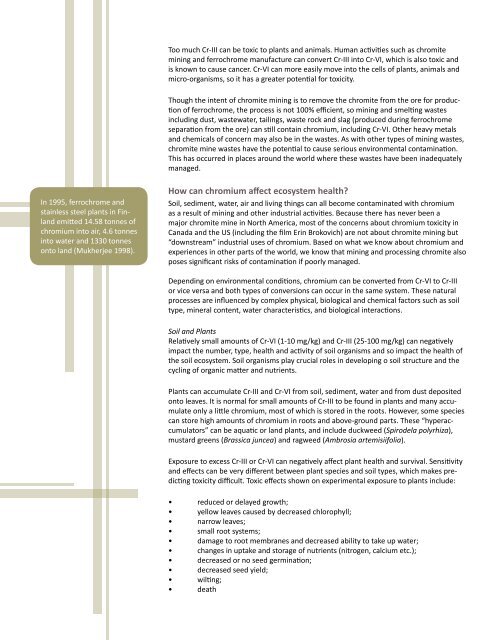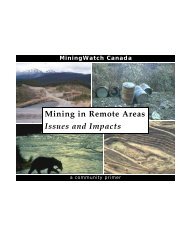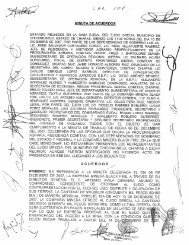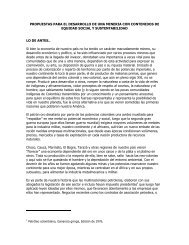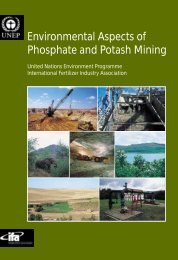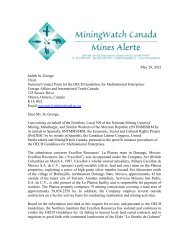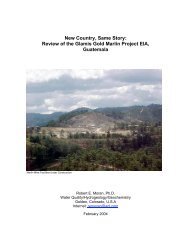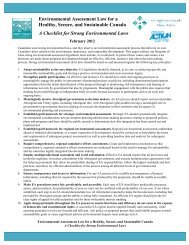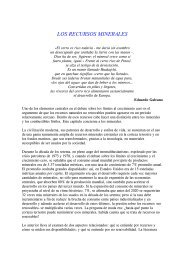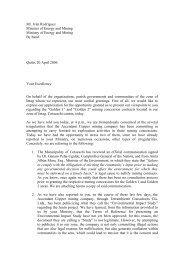Potential impacts of mining and processing chromite. Fact Sheet 1
Potential impacts of mining and processing chromite. Fact Sheet 1
Potential impacts of mining and processing chromite. Fact Sheet 1
You also want an ePaper? Increase the reach of your titles
YUMPU automatically turns print PDFs into web optimized ePapers that Google loves.
Too much Cr-III can be toxic to plants <strong>and</strong> animals. Human activities such as <strong>chromite</strong><br />
<strong>mining</strong> <strong>and</strong> ferrochrome manufacture can convert Cr-III into Cr-VI, which is also toxic <strong>and</strong><br />
is known to cause cancer. Cr-VI can more easily move into the cells <strong>of</strong> plants, animals <strong>and</strong><br />
micro-organisms, so it has a greater potential for toxicity.<br />
Though the intent <strong>of</strong> <strong>chromite</strong> <strong>mining</strong> is to remove the <strong>chromite</strong> from the ore for production<br />
<strong>of</strong> ferrochrome, the process is not 100% efficient, so <strong>mining</strong> <strong>and</strong> smelting wastes<br />
including dust, wastewater, tailings, waste rock <strong>and</strong> slag (produced during ferrochrome<br />
separation from the ore) can still contain chromium, including Cr-VI. Other heavy metals<br />
<strong>and</strong> chemicals <strong>of</strong> concern may also be in the wastes. As with other types <strong>of</strong> <strong>mining</strong> wastes,<br />
<strong>chromite</strong> mine wastes have the potential to cause serious environmental contamination.<br />
This has occurred in places around the world where these wastes have been inadequately<br />
managed.<br />
In 1995, ferrochrome <strong>and</strong><br />
stainless steel plants in Finl<strong>and</strong><br />
emitted 14.58 tonnes <strong>of</strong><br />
chromium into air, 4.6 tonnes<br />
into water <strong>and</strong> 1330 tonnes<br />
onto l<strong>and</strong> (Mukherjee 1998).<br />
How can chromium affect ecosystem health?<br />
Soil, sediment, water, air <strong>and</strong> living things can all become contaminated with chromium<br />
as a result <strong>of</strong> <strong>mining</strong> <strong>and</strong> other industrial activities. Because there has never been a<br />
major <strong>chromite</strong> mine in North America, most <strong>of</strong> the concerns about chromium toxicity in<br />
Canada <strong>and</strong> the US (including the film Erin Brokovich) are not about <strong>chromite</strong> <strong>mining</strong> but<br />
“downstream” industrial uses <strong>of</strong> chromium. Based on what we know about chromium <strong>and</strong><br />
experiences in other parts <strong>of</strong> the world, we know that <strong>mining</strong> <strong>and</strong> <strong>processing</strong> <strong>chromite</strong> also<br />
poses significant risks <strong>of</strong> contamination if poorly managed.<br />
Depending on environmental conditions, chromium can be converted from Cr-VI to Cr-III<br />
or vice versa <strong>and</strong> both types <strong>of</strong> conversions can occur in the same system. These natural<br />
processes are influenced by complex physical, biological <strong>and</strong> chemical factors such as soil<br />
type, mineral content, water characteristics, <strong>and</strong> biological interactions.<br />
Soil <strong>and</strong> Plants<br />
Relatively small amounts <strong>of</strong> Cr-VI (1-10 mg/kg) <strong>and</strong> Cr-III (25-100 mg/kg) can negatively<br />
impact the number, type, health <strong>and</strong> activity <strong>of</strong> soil organisms <strong>and</strong> so impact the health <strong>of</strong><br />
the soil ecosystem. Soil organisms play crucial roles in developing o soil structure <strong>and</strong> the<br />
cycling <strong>of</strong> organic matter <strong>and</strong> nutrients.<br />
Plants can accumulate Cr-III <strong>and</strong> Cr-VI from soil, sediment, water <strong>and</strong> from dust deposited<br />
onto leaves. It is normal for small amounts <strong>of</strong> Cr-III to be found in plants <strong>and</strong> many accumulate<br />
only a little chromium, most <strong>of</strong> which is stored in the roots. However, some species<br />
can store high amounts <strong>of</strong> chromium in roots <strong>and</strong> above-ground parts. These “hyperaccumulators”<br />
can be aquatic or l<strong>and</strong> plants, <strong>and</strong> include duckweed (Spirodela polyrhiza),<br />
mustard greens (Brassica juncea) <strong>and</strong> ragweed (Ambrosia artemisiifolia).<br />
Exposure to excess Cr-III or Cr-VI can negatively affect plant health <strong>and</strong> survival. Sensitivity<br />
<strong>and</strong> effects can be very different between plant species <strong>and</strong> soil types, which makes predicting<br />
toxicity difficult. Toxic effects shown on experimental exposure to plants include:<br />
• reduced or delayed growth;<br />
• yellow leaves caused by decreased chlorophyll;<br />
• narrow leaves;<br />
• small root systems;<br />
• damage to root membranes <strong>and</strong> decreased ability to take up water;<br />
• changes in uptake <strong>and</strong> storage <strong>of</strong> nutrients (nitrogen, calcium etc.);<br />
• decreased or no seed germination;<br />
• decreased seed yield;<br />
• wilting;<br />
• death


